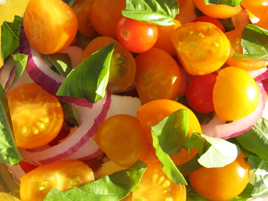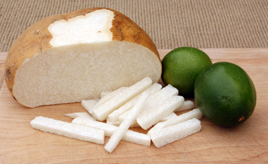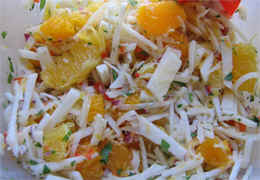Summer 2007: To Your Health
In this Issue:
- Celebrate Men’s Health Week
- Are You at Risk for Hemochromatosis?
- Colorful Salad Transformations
- On the “Road” to Food Safety
- Turn Down the Heat on Grilling
- Feature Food of the Month: Jicama
- Healthy Recipe: Jicama Salad
Celebrate Men’s Health Week – June 11-17, 2007

You may be surprised to learn that according to the Men’s Health Network, currently in America 29 million men have high blood pressure (hypertension), 50 million men have high cholesterol and 8 million men have diabetes. Do you fit into one of these categories?
The purpose of Men’s Health Week is to heighten the awareness of preventable health problems among men and boys. Men’s Health Week also aims to encourage early detection and treatment of disease. This week gives health care providers, public policy makers and the media an opportunity to encourage men and boys to seek regular medical advice and early treatment for disease and injury.
According to the Prostate Cancer Foundation, prostate cancer is the second most common cancer, following skin cancer, in men in the United States. A man has a one-in-six chance of being diagnosed with prostate cancer at some point during his life. Obese men diagnosed with the disease are 20 percent more likely to die from it than men of healthy weight.
In a recent study at the Duke University Prostate Center, it was found that obese men were 89% more likely than healthy weight men to have a more aggressive form of prostate cancer, than was indicated by biopsy. Healthy and obese men were designated as such using the body mass index scale (BMI). A BMI greater than 30 is considered obese. The researchers also found that men who were overweight (BMI 25-29.9) were 44% more likely to have a more aggressive form of prostate cancer than suggested by biopsy. The researchers speculate that the larger sized prostates in obese and overweight men make it more likely that a biopsy may miss the cancer.
So how do you keep the men in your life healthy?
In honor of Men’s Health Week…
- Take your dad/brother/uncle/grandfather/significant other to the doctor
- Ask a local nurse/doctor/ health educator to give a lecture on men’s health at your workplace, community group or senior center
- Plan a 5K walk in your town
- Plan a “Wear Blue” day to help spread the knowledge of Men’s Health Week
- Write an opinion article about men’s health and how it affects the entire family and submit it to your local newspaper
- Give Dad a Father’s Day care package, with a doctor’s appointment as a gift
- Plan a fitness activity at lunch time or after work such as walking, golfing, bowling, softball and bicycling.
Reference: Duke University Medical Center
|
Are you at risk for Hemochromatosis?

July is Hemochromatosis Awareness Month.
Hemochromatosis is an inherited condition of abnormal iron metabolism; a major cause of iron overload disease. Individuals with hemochromatosis absorb extra amounts of iron from the diet each day, which the human body cannot excrete. This excess amount of iron can reach toxic levels in tissues of major organs, such as the liver, heart, pituitary, thyroid, pancreas and joints. If the extra iron is not removed, these organs can become diseased, and ultimately lead to fatalities. Undiagnosed and untreated hemochromatosis may increase the risk for diseases and conditions such as diabetes, heart attack, arthritis, osteoporosis, liver cancer, depression, infertility, hypothyroidism and some cancers.
There are several types of hemochromatosis. At risk for the most common type are: Caucasians, men, women who do not menstruate regularly, anyone with a family history of hemochromatosis, and anyone with a genetic makeup for hemochromatosis. Chronic fatigue and joint pain are the most common symptoms for hemochromatosis. Other common symptoms may include abdominal pain, irregular heart beat, loss of sex drive, hair loss and skin color changes. In men, symptoms often begin in their late 20s and early 30s. In women, symptoms usually start about 10-15 years after they stop menstruating. When hemochromatosis is discovered early and treated before organ damage occurs, an individual can live a normal, healthy life.
People with hemochromatosis should limit the amount of red meat they eat, since it contains the most easily absorbable amount of iron. The amount of alcohol an individual drinks and how much supplemental vitamin C one takes should also be cautioned. Alcohol and vitamin C can increase the absorption of iron. It is recommended that one should limit supplemental vitamin C to 200 mg/day. Although many fresh fruits and vegetables contain vitamin C, they should NOT be eliminated from the diet, because they also contain important antioxidants, fiber and other important nutrients.
Hemochromatosis may be detected in several ways. Many tests are available to determine whether or not you have an iron overload, such as fasting serum iron, totally iron binding capacity, serum ferritin and hemoglobin. Genetic testing may also be recommended. Keep in mind, hemochromatosis is common and early detection with treatment is the key to improving quality of life.
Reference: Iron Disorders Institute
For Nutrition Tips to help Manage Hemochromatosis, please visit our special web section.
Colorful Salad Transformations

Lighten up your summer with some nutrient packed, hunger satisfying, delicious summer salads that can help to slim you down, as they fill you up! Use these tips to make your summer salads delicious and nutritious!
Color it Healthy
Create your salad from a variety of colorful fruits and vegetables to gain plenty of nutrients, fiber and phytochemicals from these foods. Phytochemicals are chemicals which plants produce that are thought to have beneficial health effects. Incorporating fruits and vegetables into your daily diet have been shown to protect against certain types of cancer, heart disease and osteoporosis, as well as helping in making your lifestyle healthier by promoting weight control! Choose a variety of colorful fruits and vegetables daily, and include them in your summer salads!
- Red: Tomatoes, watermelon, strawberries, red peppers, raspberries
- Orange: Apricots, cantaloupe, carrots, peaches, oranges, papaya
- Green: Broccoli, spinach, peas, kiwi, green peppers, lettuce
- White: Cabbage, cauliflower, onions, garlic, scallions, potatoes, bananas
- Purple/Blue: Blueberries, blackberries, red cabbage, raisins
- Yellow: Corn, yellow peppers
Make it Low-Fat
- Dress your salad with low-fat or nonfat dressings. Also add in low fat meat products, such as fish or turkey.
- For a flavorful oil based dressing, consider olive oil. Olive oil is high in monounsaturated fat which can help lower total blood cholesterol, without lowering HDL or the “good” cholesterol.
Put the Pyramid on your Plate
Have salads as your main entrée, instead of as a side dish. Include foods from all the groups of the pyramid, and transform this side dish into one delicious meal!
Try the following suggestions…
- Meat Group: Mix in meat, poultry, seafood, cooked dry beans, eggs or nuts.
- Dairy Group: Add low- fat cheese to the mix and drizzle on a yogurt based dressing.
- Bread Group: Add whole grain croutons for a crunch or whole grain rice/pasta as the base of the salad.
- Fruit Group: Try adding dried fruits such as cherries or raisins for flavor and added antioxidants which may help prevent against cancer and heart disease. Slice apples or pears with their skins on for added dietary fiber, as well as some eye appeal! Add in some sliced oranges to add brightness while giving your salad a healthy dose of vitamin C and folate.
- Fats: Almonds and walnuts are a great way to add some unsaturated fats and omega 3 fatty acids into your salad, which will help to protect against heart disease. Add one or two tablespoons of nuts to any meal for added texture and a rich taste! Also try adding some sunflower seeds into your salad for some vitamin C and added flavor.
To learn how to keep your salads safe this summer and free from food borne illness, click here.
Click here for more healthy recipes.
On the “Road” to Food Safety

July is National Picnic Month. Every year millions of families are eager to get away from the real world and enjoy a summer road trip. Whether you’re going to relax on the beach, camp in the mountains, or spend a weekend on a boat, food is always in the picture. It is important to take on various precautions when traveling with food, to assure a safe, healthy trip of family fun.
When camping…
Staying hydrated at all times when camping outdoors is very important in guaranteeing a safe vacation. Bring along bottled water, or other bottled drinks. It should not be assumed that streams and rivers are a safe source for drinking. Remember to keep the cooler and all food in a shady spot. If you are in an area with no shade, cover the cooler with a light colored blanket or tarp. Remember to keep hands clean when preparing food. Since you may not have access to clean water, it’s a good idea to bring disposable towelettes to keep hands clean.
When boating…
Make sure to bring your cooler along on the boat. Food that has been sitting out in the hot sun for more than two hours begins to spoil. If the temperature is above 90 degrees F, food will begin to spoil after just one hour of sitting out.
When at the beach…
Before your beach trip this summer, plan ahead. Try to take along only the amount of food that will be eaten, to avoid having leftovers. Partially bury the cooler in the sand as soon as you arrive at the beach, cover it with blankets and shade it with an umbrella to assure that the food remains cool and safe! If you’re choosing to dine while on the boardwalk, instead of by the shore, make sure the food stands look clean and that hot foods are served hot, and cold foods are served cold. And remember to avoid anything that has been left out in the hot sun; that’s a real invitation for a food borne illness!
When in a vacation home…
If a vacation home has not been used for a while, you may want to do a thorough house check, especially in the kitchen before moving in. If the refrigerator was unplugged from last year, thoroughly clean it before using. Make sure all food preparation areas, as well as the stove and sink are cleaned as well. Also, check the leftover canned foods. The Meat and Poultry hotline recommends that canned foods which may have been exposed to freezing and thawing temperatures over the winter be discarded.
See also: Food Safety Tips for Outdoor Summer Eating
Turn Down the Heat on Grilling

Cutting back on foods cooked at high temperatures may prevent inflammation-related conditions of aging, such as diabetes or cardiovascular disease. When grilling items on an open flame, the high heat creates toxins known as advanced glycogen end products (AGEs) or glycotoxins, which over time accumulate in the body contributing to diabetes or cardiovascular disease, among other conditions. In a study supported by the National Institute of Aging using 172 volunteers, glycotoxins in the body were shown to increase with age and are significantly correlated with AGEs in the diet, leading to increased inflammation and oxidative stress. The volunteers were divided into two groups, those younger than 45 and those older than 60. The study found that older participants, both male and female, had significantly higher serum levels of AGE derivatives compared to younger participants.
Researchers stated that these findings lead to the probable role of dietary and circulating AGEs in age-related diseases, especially of older adults. Researchers also stated that an over abundant intake of fried, broiled and grilled foods can overload the body’s natural capacity to remove AGEs so they build up in our tissues and begin to take over our body’s own built-in defenses, leading towards an eventual state of inflammation. Eventually these AGEs which are being built up in our tissues can lead to signs of early aging or disease.
This summer, consider boiling or steaming foods before putting them on the grill to avoid excessive cooking heat.
Reference: Uribarri J et. Al. Circulating Glycotoxins and Dietary Advanced Glycation Endproducts: Two Links to Inflammatory Response, Oxidative Stress and Aging. J Geron Med Sci 2007; 62A (4):427-33.
Feature Food of the Month: Jicama

Jicama is a sweet, crisp, edible root that resembles a turnip in appearance, although the plants are not related. Jicama is a member of the legume or bean family. Jicama is widely grown in Mexico and Central America, and is a popular dietary staple in Latin America. There are many names for Jicama including: the Mexican potato, Mexican yam bean, Chinese turnip and the Chinese potato. Jicama can be used as an alternative to the water chestnut. Its skin is thin and can be a variety of colors, ranging from gray, tan, or brown. You may find the outside of the root to be yellow and papery, while its inside is creamy white with a crisp texture, which resembles that of a raw potato or pear. The flavor is sweet and starchy. Jicama is usually eaten raw, sometimes with salt and lemon juice. The skin is typically peeled before eating it raw. Raw jicama tastes similar to a pear or apple. Jicama can also be cooked in soups and stir-fried dishes. When jicama is used in cooking it tends to take on the flavors of the ingredients that it is being combined with.
Jicama has very high amounts of vitamin C, is low in sodium, and has no fat. Jicama is high in carbohydrates in the form of dietary fiber. It is composed of 86-90% water. One adult serving of jicama, which is equal to 1 cup of cubed jicama, contains only 45 calories and approximately 6gm of fiber!
Jicama can be found year-round. When purchasing jicama, look for medium sized tubers that are firm and have dry roots. Do not purchase jicama that has wet, soft spots or is bruised. This may indicate that it is rotten. Overlarge examples of the tuber may not be as flavorful as smaller ones. Jicama may be stored for up to two weeks in a plastic bag in your refrigerator.
Healthy Recipe – Jicama Salad

Ingredients:
One 8-ounce jicama, peeled and cut into ½ inch sticks
1 small cucumber, thinly sliced
1 medium orange, peeled and sectioned
¼ cup white wine vinegar
2 tablespoons canola oil
1 teaspoon fresh lemon juice
¼ teaspoon chili powder
¼ teaspoon salt
Instructions:
1. Combine the jicama, cucumber and orange segments in a serving bowl.
2. Whisk together the vinegar, oil, lemon juice, chili powder, and salt. Pour over the jicama mixture; toss well. Chill.
Yield: 4 servings
Serving Size: ½ cup
Exchanges: ½ fruit, 1 vegetable, ½ fat, monounsaturated
Nutrition Facts:
Calories = 114
Total Fat = 7 grams
Saturated Fat = 1 gram
Cholesterol = 0 milligrams
For more healthy recipes, click here.

Leave a Reply
Want to join the discussion?Feel free to contribute!